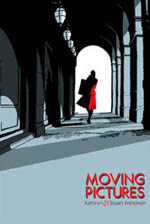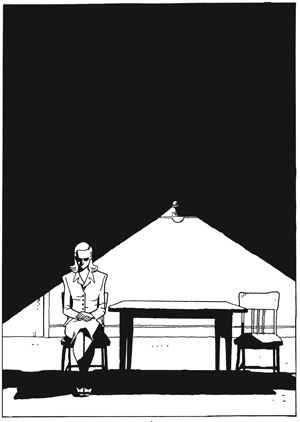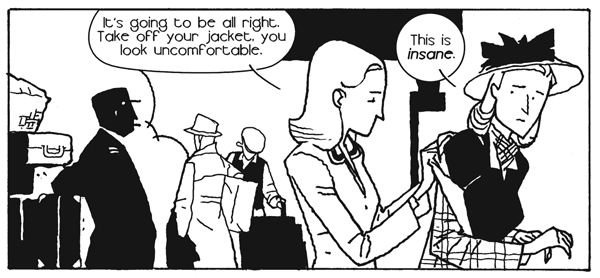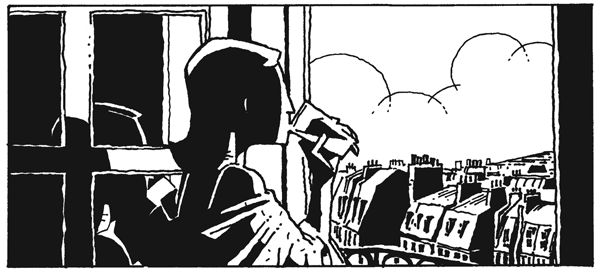 Written by Kathryn Immonen
Written by Kathryn Immonen
Art by Stuart Immonen
144 pages, black and white
Published by Top Shelf Productions
One of the things I’ve come to expect from Kathryn Immonen is that she doesn’t write stories that talk down to her readers. There’s always a lot packed into her scripts, both what’s being directly stated as well as what you have to piece together and infer for yourself. The end result is a reading experience that ends up being that much more rewarding when you hit the conclusion, and that’s something on display in her and Stuart Immonen’s new graphic novel Moving Pictures.
 Stories set in World War II are a dime a dozen, but right off the bat Kathryn Immonen takes it in a different direction than most, letting her story revolve around a Canadian woman, Ila, who is trying to catalog and relocate as many works of art from the basement of a Parisian museum to keep them safe from German forces and the fighting that has broken out throughout the country. It’s a nice twist on the normal "resistance" story, shuffling paintings instead of people.
Stories set in World War II are a dime a dozen, but right off the bat Kathryn Immonen takes it in a different direction than most, letting her story revolve around a Canadian woman, Ila, who is trying to catalog and relocate as many works of art from the basement of a Parisian museum to keep them safe from German forces and the fighting that has broken out throughout the country. It’s a nice twist on the normal "resistance" story, shuffling paintings instead of people.
Of course, there’s more to Moving Pictures than just moving art around. The bulk of the book involves an extended interview session between Ila Gardner and Rolf Hauptmann, a German officer. That’s where Kathryn Immonen starts playing with her reader, letting her characters start circling around one another in a careful dance where Kathryn Immonen doesn’t let you know the intended destination, or even who is truly leading the other. That’s left up to you, trying to piece together the sequence of events and what exactly the Germans are looking for in their questioning of Ila. As Kathryn Immonen’s narrative jumps into flashbacks and then back to the present with no warning, you’re left to question who or what—if anything at all—is being saved.
I don’t mean to make it sound like Kathryn Immonen’s writing is obtuse, because it’s not. It’s actually carefully constructed, moving you step by step through a sequence that Immonen has carefully mapped out to its conclusion. Even people who might get lost by the turns and detours throughout Moving Pictures on their first read-through will still have a lot to enjoy here, for that matter. I love the way Kathryn Immonen writes dialogue; it has such a natural flow to its construction that it comes across as sounding more real than just about any other writer in comics. And when Ila and her fellow workers talk about art, it’s a joy to just sit back and read what comes out of their mouths.

I’m not used to seeing Stuart Immonen draw a black and white book, but seeing his work here makes me yearn to see more from him where he doesn’t have a colorist to fill in the details. Stuart Immonen uses the stark black and white look as a tool in its own right, from the very first page with Ila sitting in a triangle of light in an otherwise dark room, to the effect of white pages falling amidst a black background. Stuart Immonen uses a thin line with sharp edges here, something that those used to his softer art with inker Wade von Grawbadger might find a little surprising. It’s a great look though, interacting not only with the dark interrogation room as it slices its people into focus, but with the slightly ragged edges of the museum and the streets of Paris. Even people in the backgrounds are often cloaked in shadow, pushing them into the foreground or background as needed. It’s a effective use the dark inks, and he doesn’t miss a trick. Stuart Immonen sticks with variations on a six-panel grid here for his pages, not resorting to trickery but instead providing a straight-forward, easy to read progression of action from one panel to the next. It’s good solid storytelling, and considering a large portion of the book is two people talking in a darkened room, Stuart Immonen is able to still bring tension to Kathryn Immonen’s script.

Moving Pictures is the kind of book you’ll want to read two or three times to fully enjoy, each journey through war-torn Paris revealing something new and interesting to the reader. Kathryn Immonen is proving herself to be a writer to watch for, and her leap into a new genre here shows great strength and familiarity with it already. I’ve enjoyed Kathryn Immonen’s work at Marvel to date, but Moving Pictures is easily my favorite of her comics yet. Whatever Kathryn and Stuart Immonen work on together next, I’m already sold. Make time in your reading schedule to fit this book in.
Purchase Links: Amazon.com | Powell’s Books
